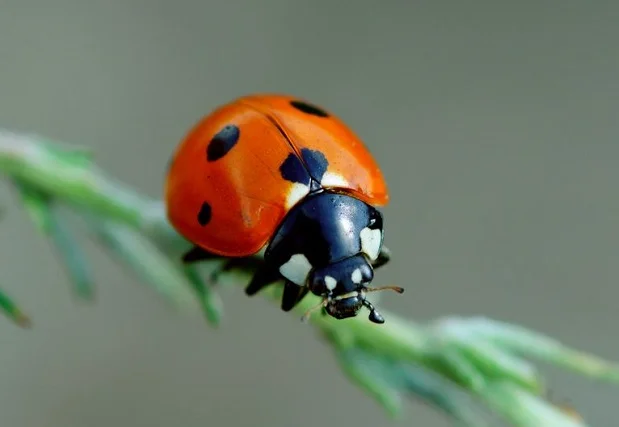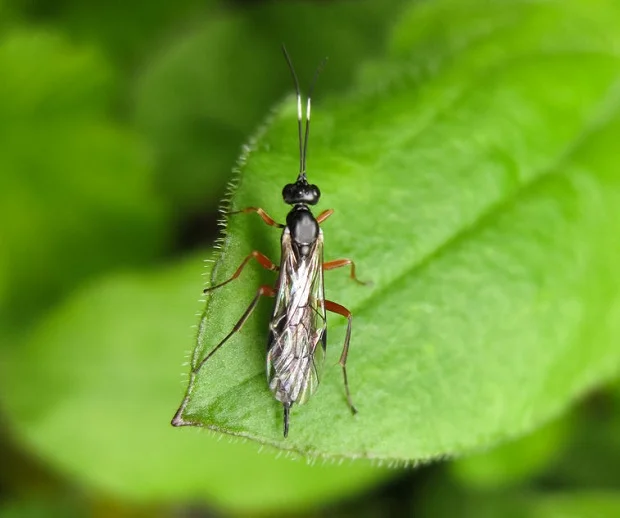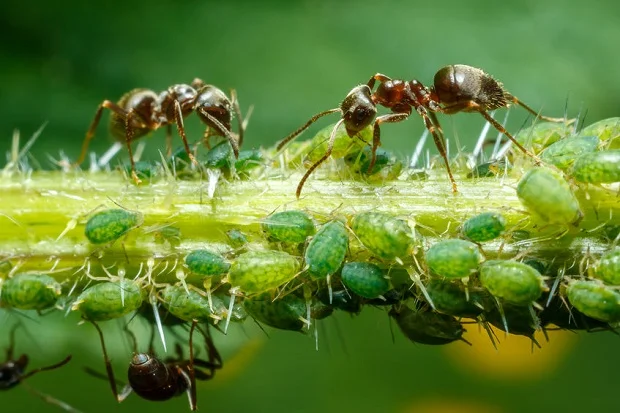What Eats Aphids?
Answer at a Glance: Many predatory beneficial insects eat aphids including lady beetles, parasitic wasps, syrphid flies, big-eyed bugs, minute pirate bugs, and damsel bugs.
Beneficial Insects That Eat Aphids
Lady Beetles

Convergent lady beetles and the seven spotted lady beetles are natural predators of aphids. Convergent lady beetles are the most common species found in North America and the species that is most widely sold commercially as a natural aphid predator. [1]
If you are planning to purchase commercial lady beetles, you should be aware of the many problems that can occur with this method of aphid control. For optimal success, check out “Ladybugs Need Special Care to Control Aphids in the Garden” from the University of California Division of Agricultural and Resources.
| 📌Fun Fact: According to the University of California, Division of Agriculture and Natural Resources, a single adult convergent lady beetle can consume 50 or more aphids per day. [2]
Parasitic Wasps

Parasitic wasps are one the most important natural enemies of aphid populations. The female wasp lays an egg inside of an aphid by injecting it into its body cavity. The larva then feeds on the aphid from the inside out. The aphid will eventually mummify and die, at which time the now-adult wasp eats a hole through the aphid’s abdomen to escape.
If you would like to see this process in action through images, check out these images from the University of California Agriculture and Natural Resources website of the wasp injecting the egg into the aphid, mummified aphids, and a mummy with an exit hole.
| 🤩 A Wow Moment: The parasitic wasp usually lays one egg per aphid but is capable of laying hundreds of eggs a day! [3]
Syrphid Flies
Syrphids, also known as flower flies or hoverflies, are another aphid predator. Many syrphid fly species resemble bees and wasps but have only one set of wings. They most commonly feed on soft-bodied insects such as mealybugs, but their main diet consists of aphids. The syrphid fly larva can ingest 100-400 aphids before it pupates, depending on its size. Interestingly, once syrphids become adults, they are no longer predatory, instead feeding on honeydew, nectar, and pollen, making them important pollinators. [4]
Big-Eyed Bugs
Big-eyed bugs have a varied diet of insect eggs, mites, and aphids. These bug predators don’t consume their prey. They are equipped with needle-like mouthparts that they use to inject digestive enzymes that dissolve the insides of the prey that they then suck out. [5]
Minute Pirate Bugs
Minute pirate bugs feed on mites and small insects, primarily thrips and mites, but aphids are also a staple in their diets. These predatory insects have needle-like sucking mouthparts that drain the fluid from their prey. [6]
Damsel Bugs
Damsel bugs eat a wide variety of insects, including aphids. Like the minute pirate bug, the damsel bug also has a needle-like sucking mouthpart that it uses the suck the fluid from its prey. [7]
Do Ants Eat Aphids?

Ants do not eat aphids. In fact, ants play an interesting role in the protection of the pest. Because aphids excrete a sticky, sweet substance called “honeydew” that ants consume, the two enjoy a mutualistic relationship. Ants will kill the larvae of aphid predators to protect their honeydew source. They also look after their well-being, herding them like cows and moving them to a new food source when the current one is depleted. [8]
Amazingly, ants also protect aphids from lethal fungal infections. In field experiments, scientists noted that aphids that had succumbed to lethal fungal infections were quickly removed from the ant-protected colonies. The ants were also able to detect the fungus on living aphids and promptly worked to groom the aphids or remove them from the colony. [9]
📚References
- [1] The University of Florida Department of Entomology and Nematology – “Featured Creatures – Convergent Lady Beetles.”
- [2] University of California Division of Agricultural and Resources – “Ladybugs Need Special Care to Control Aphids in the Garden.”
- [3] University of California Division of Agricultural and Resources – “Natural Enemies – Parasitic Wasps.”
- [4] University of California Division of Agricultural and Resources – “Syrphids (Flower Flies, or Hover Flies)”
- [5] North Carolina State University Extension – “Entomology – Insect and Biology Management – Big-Eyed Bugs.”
- [6] University of California Division of Agricultural and Resources – “Natural Enemies – Minute Pirate Bugs.”
- [7] University of California Division of Agricultural and Resources – “Natural Enemies – Damsel Bugs.”
- [8] Texas A&M AgriLife Extension – “Fire Ants’ Aphid-Ranching Skills May Be Key to Their Successful US Invasion. ”
- [9] Nielsen, Charlotte, et al. “Ants Defend Aphids against Lethal Disease.” Biology Letters, vol. 6, no. 2, 2009, pp. 205–208. https://doi.org/10.1098/rsbl.2009.0743.
